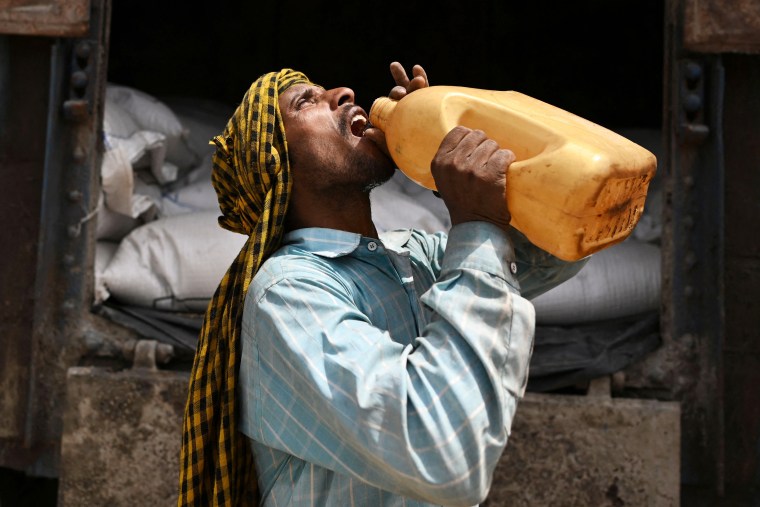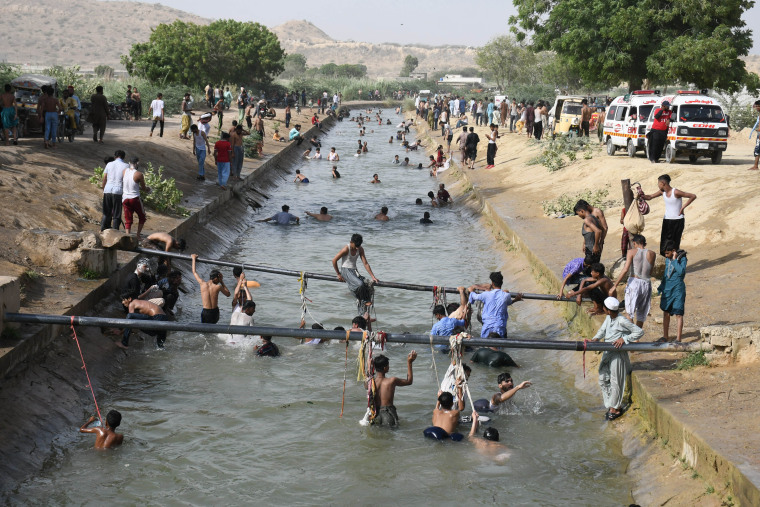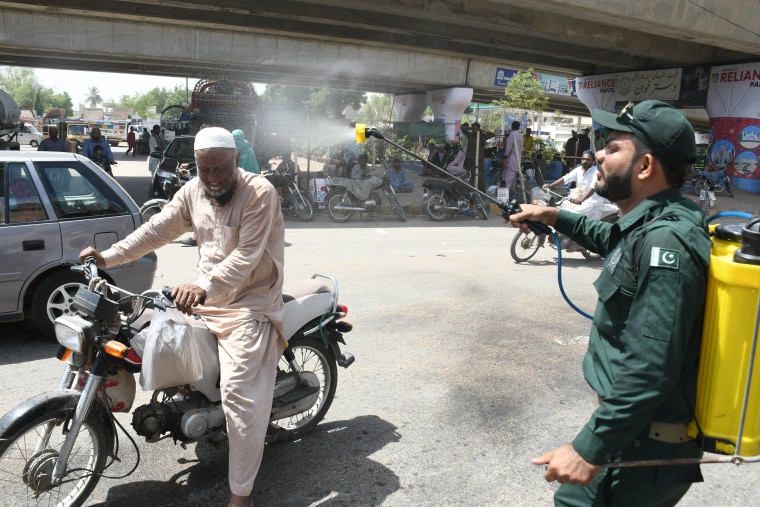Millions in India and Pakistan have had to toil through the hottest spring on record, in conditions that scientists fear will soon regularly afflict billions across the globe.

A worker drinks water during a break from loading sacks of wheat on a freight train in Khanna, India on Thursday.
Sajjad Hussain / AFP via Getty Images
Link copiedMay 21, 2022,
By Anisha Kukreja, Patrick Galey and Kaswar Klasra
NEW DELHI, India — Street vendor Rohan Mishra wakes before dawn to buy fresh vegetables from the bazaar and steels himself for another day hauling his cart under the punishing New Delhi sun.
Unable to afford time off during India’s record-shattering heat wave, he endures headaches, dizzy spells and nosebleeds as he desperately tries to hawk his produce before it withers in the basket.
“Money has been difficult recently,” Mishra said. “This [weather] is torturous. I frequently have to throw away vegetables because they become mushy and spoil in the heat. We already buy at a steep price because the hot weather has been affecting the harvest.”
Mishra is one of millions of laborers in India and Pakistan who have had to toil through the hottest spring on record, in conditions that scientists fear will soon regularly afflict billions across the globe and contribute to a looming food crisis.

Link copiedMay 21, 2022,
By Anisha Kukreja, Patrick Galey and Kaswar Klasra
NEW DELHI, India — Street vendor Rohan Mishra wakes before dawn to buy fresh vegetables from the bazaar and steels himself for another day hauling his cart under the punishing New Delhi sun.
Unable to afford time off during India’s record-shattering heat wave, he endures headaches, dizzy spells and nosebleeds as he desperately tries to hawk his produce before it withers in the basket.
“Money has been difficult recently,” Mishra said. “This [weather] is torturous. I frequently have to throw away vegetables because they become mushy and spoil in the heat. We already buy at a steep price because the hot weather has been affecting the harvest.”
Mishra is one of millions of laborers in India and Pakistan who have had to toil through the hottest spring on record, in conditions that scientists fear will soon regularly afflict billions across the globe and contribute to a looming food crisis.

A man sells watermelons from a canal on a hot summer afternoon in Jammu, India, on Thursday.
Channi Anand / AP
The U.N.’s climate science panel said in February that more than 430 million people globally were exposed to extreme heat in 2020.
Depending on how quickly the global economy reins in carbon emissions, it warned that between half and two-thirds of humanity would be “exposed to periods of life-threatening climatic conditions arising from coupled impacts of extreme heat and humidity” this century.
It said the burden will be disproportionately felt by the urban poor in regions of sub-Saharan Africa and South Asia.
Shouro Dasgupta, an environmental economist at the Euro-Mediterranean Center on Climate Change in Italy, said heat waves are especially difficult for people who work outdoors in industries such as agriculture and construction.
“India, Pakistan and Bangladesh have a huge number of people working in these sectors, so the underlying inequality in impacts is significant already,” he said.
India — the world’s second-largest wheat producer after China — banned most exports last week after its hottest March on record hit harvests across the north of the country. This caused the price of wheat, already up some 60 percent this year because of Russia’s invasion of Ukraine, to shoot up once again.
In Pakistan, temperatures have been 3 degrees Celsius (5.4 Fahrenheit) hotter than average for several months, leading to livestock loss and putting the population under even greater water stress.
The city of Jacobabad in Sindh province hit almost 124 degrees Fahrenheit last weekend, with average daily highs of 113 degrees throughout May.

The U.N.’s climate science panel said in February that more than 430 million people globally were exposed to extreme heat in 2020.
Depending on how quickly the global economy reins in carbon emissions, it warned that between half and two-thirds of humanity would be “exposed to periods of life-threatening climatic conditions arising from coupled impacts of extreme heat and humidity” this century.
It said the burden will be disproportionately felt by the urban poor in regions of sub-Saharan Africa and South Asia.
Shouro Dasgupta, an environmental economist at the Euro-Mediterranean Center on Climate Change in Italy, said heat waves are especially difficult for people who work outdoors in industries such as agriculture and construction.
“India, Pakistan and Bangladesh have a huge number of people working in these sectors, so the underlying inequality in impacts is significant already,” he said.
India — the world’s second-largest wheat producer after China — banned most exports last week after its hottest March on record hit harvests across the north of the country. This caused the price of wheat, already up some 60 percent this year because of Russia’s invasion of Ukraine, to shoot up once again.
In Pakistan, temperatures have been 3 degrees Celsius (5.4 Fahrenheit) hotter than average for several months, leading to livestock loss and putting the population under even greater water stress.
The city of Jacobabad in Sindh province hit almost 124 degrees Fahrenheit last weekend, with average daily highs of 113 degrees throughout May.

People cool off in a canal during hot weather in Karachi, Pakistan earlier this week.
Sabir Mazhar / Anadolu Agency via Getty Images
“Pakistan is among the 10 most affected countries from climate change and the third-most vulnerable to water stress,” said Federal Minister for Climate Change Sherry Rehman.
“The current heat wave has just worsened the situation when it comes to availability of water.”
March was Pakistan’s driest month on record, while April was the hottest since weather data began, according to Sardar Sarfraz, chief meteorological officer in Sindh.
A study published this week by Britain’s national meteorological service said that climate change had made record-breaking heat waves in northwest India and Pakistan more than 100 times more likely, meaning that instead of occurring once every three centuries under natural conditions, they are now likely to take place every three years. The study also found that based on current climate change projections, by the end of the century the region could be experiencing extreme heat waves every year.
Dasgupta said such heat waves have “cascading impacts” around the world, starting with smaller food harvests.
“Climate shocks affect yields, which reduces supply in the global market, and countries, instead of cooperating, begin to keep stores for themselves,” he said.
“This puts upward pressure on prices, which further reduces the purchasing power of people and results in increased food insecurity.”
As recently as last month, India said it hoped to make up for some of the shortfall in global wheat supplies from Russia and Ukraine, two of the world’s biggest producers, before lower yields prompted it to announce the export ban.
But Dasgupta said that even before the war in Ukraine and the pandemic, “new climate stressors have been exerting huge pressure on the global food chain.”
“Whether it’s in Madagascar or India, or multiple African countries, we’ve seen this for a while — it’s a dual shock of heat waves and droughts,” he said.

“Pakistan is among the 10 most affected countries from climate change and the third-most vulnerable to water stress,” said Federal Minister for Climate Change Sherry Rehman.
“The current heat wave has just worsened the situation when it comes to availability of water.”
March was Pakistan’s driest month on record, while April was the hottest since weather data began, according to Sardar Sarfraz, chief meteorological officer in Sindh.
A study published this week by Britain’s national meteorological service said that climate change had made record-breaking heat waves in northwest India and Pakistan more than 100 times more likely, meaning that instead of occurring once every three centuries under natural conditions, they are now likely to take place every three years. The study also found that based on current climate change projections, by the end of the century the region could be experiencing extreme heat waves every year.
Dasgupta said such heat waves have “cascading impacts” around the world, starting with smaller food harvests.
“Climate shocks affect yields, which reduces supply in the global market, and countries, instead of cooperating, begin to keep stores for themselves,” he said.
“This puts upward pressure on prices, which further reduces the purchasing power of people and results in increased food insecurity.”
As recently as last month, India said it hoped to make up for some of the shortfall in global wheat supplies from Russia and Ukraine, two of the world’s biggest producers, before lower yields prompted it to announce the export ban.
But Dasgupta said that even before the war in Ukraine and the pandemic, “new climate stressors have been exerting huge pressure on the global food chain.”
“Whether it’s in Madagascar or India, or multiple African countries, we’ve seen this for a while — it’s a dual shock of heat waves and droughts,” he said.

A Pakistani volunteer sprays water on people to keep them cool during hot weather in Karachi earlier this week.
Sabir Mazhar / Anadolu Agency via Getty Images
The health and economic impacts of heat waves stretch far beyond food supply. Soaring temperatures in India have been accompanied by a surge in demand for electricity, leading to acute power outages and raising questions about the country’s dependence on coal.
Nidhi Singh, a postdoctoral researcher at the Leibniz Research Institute for Environmental Medicine in Germany who has studied the health impacts of heat waves in India, said a mixture of poverty and inadequate infrastructure made for the perfect storm when temperatures soared.
Most lower-income families lack access to refrigeration, cold water or air-conditioning — a potentially deadly situation, especially when extreme heat combines with high humidity to create “wet bulb” temperature spikes. High wet-bulb temperatures can hamper the human body’s ability to cool itself through perspiration, meaning just a few hours’ exposure can kill even healthy individuals.
Singh said that even during low-humidity hot spells, older people with underlying health conditions such as lung or heart issues are particularly vulnerable. There is also greater risk of contracting illnesses such as diarrhea, which kills more than half a million children under 5 each year.
“When you don’t have refrigeration, you eat spoiled foods and you can get sick,” Singh said.
Dasgupta said that farmers in the region were increasingly contracting kidney disease as they are unable to find enough water to drink throughout the day when temperatures soar. Female workers are disproportionately affected, since many farms don’t provide toilet facilities.
“And we will continue to see these impacts as we see more and more heat wave events such as those in India and Pakistan right now,” he said.
Anisha Kukreja reported from New Delhi, Patrick Galey reported from Paris and Kaswar Klasra reported from Islamabad.
The health and economic impacts of heat waves stretch far beyond food supply. Soaring temperatures in India have been accompanied by a surge in demand for electricity, leading to acute power outages and raising questions about the country’s dependence on coal.
Nidhi Singh, a postdoctoral researcher at the Leibniz Research Institute for Environmental Medicine in Germany who has studied the health impacts of heat waves in India, said a mixture of poverty and inadequate infrastructure made for the perfect storm when temperatures soared.
Most lower-income families lack access to refrigeration, cold water or air-conditioning — a potentially deadly situation, especially when extreme heat combines with high humidity to create “wet bulb” temperature spikes. High wet-bulb temperatures can hamper the human body’s ability to cool itself through perspiration, meaning just a few hours’ exposure can kill even healthy individuals.
Singh said that even during low-humidity hot spells, older people with underlying health conditions such as lung or heart issues are particularly vulnerable. There is also greater risk of contracting illnesses such as diarrhea, which kills more than half a million children under 5 each year.
“When you don’t have refrigeration, you eat spoiled foods and you can get sick,” Singh said.
Dasgupta said that farmers in the region were increasingly contracting kidney disease as they are unable to find enough water to drink throughout the day when temperatures soar. Female workers are disproportionately affected, since many farms don’t provide toilet facilities.
“And we will continue to see these impacts as we see more and more heat wave events such as those in India and Pakistan right now,” he said.
Anisha Kukreja reported from New Delhi, Patrick Galey reported from Paris and Kaswar Klasra reported from Islamabad.
No comments:
Post a Comment